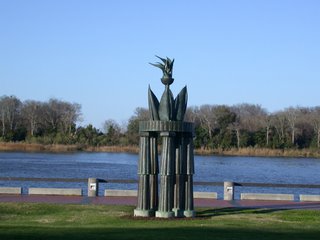 Florence Martus
Florence MartusAs we approached the waterfront on River Street in Savannah, we noticed two memorials. The first was a memorial to the 1996 Olympics, during which Savannah hosted the yachting events.
The second memorial is a statue of the Waving Girl, a 1971 statue by Felix De Weldon that honors Florence Martus, a Savannahian who greeted every ship entering the port from 1887 to 1931 by waving a cloth from her home on Elba Island. Let me provide a little interesting history concerning Florence Martus. For 44 years, Florence Martus met every ship entering the Savannah River and every outgoing ship headed for the uncertainties of the Atlantic Ocean. She became a seafaring legend.
Martus was born on Cockspur Island Aug. 8, 1868, in a frame building just north of Fort Pulaski. Her father, John Martus, a Civil War veteran, had recently completed 40 years in the U.S. Army and was assigned as ordnance sergeant at the fort. Until she was 13, Florence and her brother George led uneventful lives. But in 1881, a hurricane heading for Savannah blasted tiny Cockspur Island. Her family, fleeing the wrath of the storm, sought refuge in the nearby fort. But it too was threatened when water began to pour into the parade grounds. The Martus family finally found safety in one of the spiral stairwells deep within the fort. During another colorful summer, Martus and her brother rescued the 31-man crew from a government dredge that had caught fire. All, except one of the crew members, survived.
When George accepted a job with the Lighthouse Service in 1887, Florence moved with him to the lighthouse keeper's house on Elba Island. It was at the cottage (a white, two-story house with a columned porch) that Martus, 19, began greeting ships. Waving a white handkerchief by day and a lantern by night, she welcomed both incoming ships and outgoing vessels. She claimed to have waved at every vessel during her 44 years on Elba Island. Years later, when asked in an interview with Ernie Pyle if she ever missed a ship in all that time, she replied: "I was never too sick to get up when one was coming and I could always hear them coming."
In time, Martus earned the nickname "The Waving Girl" and became known throughout the seafaring world, receiving letters from hundreds of sailors. Romantic stories emerged. The most popular story was that of a sailor sweetheart who was lost at sea. She waved at other seamen, the story goes, as a tribute to her lost love. She never verified the story, but she never denied it either.
A passenger, on board a New York-to-Savannah steamer during the first quarter of the 20th century, recalled Martus' greeting: "The first I saw of her was at sunrise. The little white cottage where she lived was close to the bank. She was a little thing, thin, but sturdy looking. The wind (was) whipping at her skirt and almost tore the cloth out of her hand. The sun showed her hair as gray and curly with red color still in it. Her eyes were blue. She wasn't pretty, but so alive. Her smile was one of the warmest I've ever seen. We saluted her with three blasts. I followed the ship's rail all the way to the stern, looking at her as long as she was visible."After George retired from the Lighthouse Service in 1931, Florence, who never married, moved with him to an apartment at 642 E. Liberty St. From Liberty Street she moved to Thunderbolt. To celebrate her 70th birthday, 3,000 people descended upon the parade grounds at Fort Pulaski. Two bands, the U.S. Marine Corps Band, and the Savannah Police Department Band, played while the Coast Guard cutter Tallapoose fired a salute.
On a cold and windy November day in 1943, a liberty ship, the S.S. Florence Martus, slipped smoothly away after a champagne christening. She was the 13th of 88 liberty ships built during World War II in one of the largest ship-building programs in U.S. history. Martus, who had greeted so many vessels, died a few months later. Florence Martus died on February 8, 1943, of bronchial pneumonia. Along with her family she rests in historic Laurel Grove Cemetery.
On the banks of the Savannah River, at the east end of River Street, a 17-foot statue was erected in Martus' memory. The statue of a young woman, with a collie at her side, waves a handkerchief and continues to welcome seamen from around th
 e world.
e world.


0 Comments:
Post a Comment
<< Home